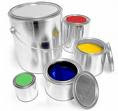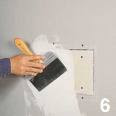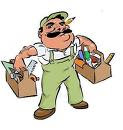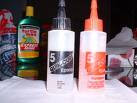Drywall Repair Starts with the Right Tools
Drywall repair and installation is much easier if you have the right tools for the job. Using inferior drywall tools could produce unsatisfactory results. Drywall repair, installation and finishing takes time and effort; begin with the correct tools to do the job right.
There is no need to by the professional tools like the combination mud and tape dispensers unless you are planning to go into the drywall installation business; however, you do need to choose quality tools. Here are the basic tools the do-it-yourselfer needs for repairing or installing drywall:
Mud Pan – Choose a stainless steel pan that won’t rust; do not use the plastic pan with the metal strip which tends to rust.
Drywall Knife – Choose a 4 – 4-1/2 inch steel knife; one with a good quality name that won’t rust. This is the one to use with taping because it fits into the joints where two beveled edges of drywall meet, making it easier to imbed the tape.
Finishing Knife – Choose a good quality, 10” steel knife for the finishing coat to feather out the edges of the seam.
Corner Tool – Some people prefer the plastic but there are good quality steel corner tools too.
Other tools include a tape measure, T-Square, utility knife, drywall saw and a cordless drill/driver.
There are some basic supplies you will need as well:
Tape – Professionals prefer the paper tape; some homeowners like the mesh tape. Paper tape is much easier to cover and the best choice for taping seams.
Mud – All Purpose Joint Compound is the easiest to use and the least expensive. It comes in two different kinds; the one in the green bucket is the best. You can also buy the powder and mix it, but it hardens quickly and is only recommended for professional use.
Drywall Screws – Do not substitute a different type of screw; be sure to use drywall screws.
Once the drywall repair is done and the mud is dry you will need to sand it. Either use sandpaper or drywall sanding screen. Both come in various grit count for early sanding and final, finish sanding.
Even the do-it-yourselfer should choose high quality tools to get the best results; however, it isn’t necessary to buy professional tools. For the hand tools, be sure to choose brand names that you know are high-quality.
Paul Doughty owns and operates HandyPro Handyman Services, a one-stop professional, honest and trusted handyman service who does a wide variety of jobs; large and small; all with high-quality workmanship. Paul services consumers and businesses in Colorado Springs, Manitou Springs, Fountain, Monument, and neighboring cities and communities in El Paso County, Colorado.
80829, 80817, 80132, 80902, 80903, 80904, 80905, 80906, 80907, 80908, 80909, 80910, 80911, 80912, 80913, 80915, 80916, 80917, 80918, 80919, 80920, 80921, 80922, 80923, 80924
Wednesday, November 25, 2009
Handyman Services in El Paso County – Tips for Maintaining your Vinyl Floor
Your new vinyl floor is a beautiful, long lasting, durable product that will withstand years of use and some abuse, but it can be permanently damaged if it is not cared for properly. Here are some recommended handyman tips for maintaining your vinyl floor.
Wipe up all spills as soon as possible and mop regularly with a no-rinse floor cleaner. Use a floor stripper and cleaner for heavy duty cleaning and a no-wax shine keeper if it begins to dull over time.
Our handyman advises that you do not use detergents or abrasive cleaners. Certain mop and shine products may leave a dull film on the floor. Do not use paste wax or solvent-based polishes. Do not vacuum with a beater bar because it can visibly damage the floor surface and do not use highly abrasive scrubbing tools.
There are steps you can take to prevent damage to your vinyl floor. When moving heavy furniture or appliances, lay plywood and “walk” the item across it to avoid scuffing and tearing the vinyl. Use floor protectors on furniture to reduce indentation. The heavier the item, the wider the floor protector you need. Furniture with metal protectors can leave deep indentations and leave rust stains. Some rolling casters can also do damage. If you must use casters, the double-wheel type is your best option.
Place a mat at the entrance to reduce the amount of dirt that is tracked into the house. Rubber or latex- backed mats are not recommended because the chemical used to keep the backing from becoming brittle can permanently stain the floor. Use a non-staining vinyl-backed mat or a colorfast rug.
Our handyman advises preventative measures you can take immediately after installing your new vinyl floor. Be sure to protect sealed seams for at least 8 hours after installation to ensure a proper seam bond. If seams not protected until they’re dry, permanent damage can result.
Maintain room temperature of at least 65 degrees for 48 hours after installation to assure proper curing, setting and bonding of products. Take care to avoid spills and dirt for at least five days after installing as mopping is not recommended on a new vinyl floor because the adhesive needs time to dry thoroughly.
Vinyl flooring is quite durable, but it is not stain-proof. Many stains are removable, but some are not. Be careful when using stain removal products, testing them first in inconspicuous places to be sure they do not dull or damage the finish. Wipe spills quickly, as soon as the happen to reduce staining.
Read labels on floor stain removal products to be sure they are appropriate for vinyl floors. Many stains can be removed with alcohol, mineral spirits or turpentine. Scrub the area with floor stripper and cleaner, using a nonabrasive scrubbing pad. Read and follow all instructions on the label. Nail polish remover can also be used for some stains, sparingly and carefully, washing thoroughly after using.
Your vinyl floor requires very little maintenance besides regular cleaning. Be careful when using new products and be sure to pre-test in places that are not noticeable to avoid permanent damage to your floor. Use care when moving furniture and appliances. Read all labels on cleaning products to be sure they are specifically designed for vinyl floors.
Paul Doughty owns HandyPro Handyman Services, specializing in minor repairs and improvements for homeowners and associations, businesses, apartment complexes and condominiums in Colorado Springs, Manitou Springs, Fountain, Monument, and neighboring cities and communities in El Paso County, Colorado.
80829, 80817, 80132, 80902, 80903, 80904, 80905, 80906, 80907, 80908, 80909, 80910, 80911, 80912, 80913, 80915, 80916, 80917, 80918, 80919, 80920, 80921, 80922, 80923, 80924
Wipe up all spills as soon as possible and mop regularly with a no-rinse floor cleaner. Use a floor stripper and cleaner for heavy duty cleaning and a no-wax shine keeper if it begins to dull over time.
Our handyman advises that you do not use detergents or abrasive cleaners. Certain mop and shine products may leave a dull film on the floor. Do not use paste wax or solvent-based polishes. Do not vacuum with a beater bar because it can visibly damage the floor surface and do not use highly abrasive scrubbing tools.
There are steps you can take to prevent damage to your vinyl floor. When moving heavy furniture or appliances, lay plywood and “walk” the item across it to avoid scuffing and tearing the vinyl. Use floor protectors on furniture to reduce indentation. The heavier the item, the wider the floor protector you need. Furniture with metal protectors can leave deep indentations and leave rust stains. Some rolling casters can also do damage. If you must use casters, the double-wheel type is your best option.
Place a mat at the entrance to reduce the amount of dirt that is tracked into the house. Rubber or latex- backed mats are not recommended because the chemical used to keep the backing from becoming brittle can permanently stain the floor. Use a non-staining vinyl-backed mat or a colorfast rug.
Our handyman advises preventative measures you can take immediately after installing your new vinyl floor. Be sure to protect sealed seams for at least 8 hours after installation to ensure a proper seam bond. If seams not protected until they’re dry, permanent damage can result.
Maintain room temperature of at least 65 degrees for 48 hours after installation to assure proper curing, setting and bonding of products. Take care to avoid spills and dirt for at least five days after installing as mopping is not recommended on a new vinyl floor because the adhesive needs time to dry thoroughly.
Vinyl flooring is quite durable, but it is not stain-proof. Many stains are removable, but some are not. Be careful when using stain removal products, testing them first in inconspicuous places to be sure they do not dull or damage the finish. Wipe spills quickly, as soon as the happen to reduce staining.
Read labels on floor stain removal products to be sure they are appropriate for vinyl floors. Many stains can be removed with alcohol, mineral spirits or turpentine. Scrub the area with floor stripper and cleaner, using a nonabrasive scrubbing pad. Read and follow all instructions on the label. Nail polish remover can also be used for some stains, sparingly and carefully, washing thoroughly after using.
Your vinyl floor requires very little maintenance besides regular cleaning. Be careful when using new products and be sure to pre-test in places that are not noticeable to avoid permanent damage to your floor. Use care when moving furniture and appliances. Read all labels on cleaning products to be sure they are specifically designed for vinyl floors.
Paul Doughty owns HandyPro Handyman Services, specializing in minor repairs and improvements for homeowners and associations, businesses, apartment complexes and condominiums in Colorado Springs, Manitou Springs, Fountain, Monument, and neighboring cities and communities in El Paso County, Colorado.
80829, 80817, 80132, 80902, 80903, 80904, 80905, 80906, 80907, 80908, 80909, 80910, 80911, 80912, 80913, 80915, 80916, 80917, 80918, 80919, 80920, 80921, 80922, 80923, 80924
Labels:
Handyman service,
home maintenance,
Home Repairs,
vinyl floors
Subscribe to:
Comments (Atom)

















